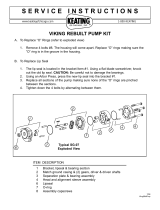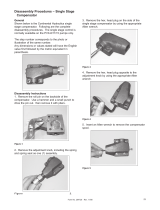
Introduction
Using this manual.............................................................................................................................................................................5
Safety precautions............................................................................................................................................................................5
Unintended machine movement..........................................................................................................................................5
Flammable cleaning solvents.................................................................................................................................................5
Fluid under pressure..................................................................................................................................................................5
Personal safety.............................................................................................................................................................................5
Symbols used in Danfoss literature............................................................................................................................................6
General description......................................................................................................................................................................... 6
The system circuit.............................................................................................................................................................................7
Technical specifications
General specifications.....................................................................................................................................................................9
Type of mounting....................................................................................................................................................................... 9
Auxiliary mounting pad options............................................................................................................................................9
Control options............................................................................................................................................................................9
Port options...................................................................................................................................................................................9
Direction of rotation...................................................................................................................................................................9
Installation position....................................................................................................................................................................9
Technical specifications............................................................................................................................................................9
Hydraulic parameters................................................................................................................................................................... 10
Inlet pressure..............................................................................................................................................................................10
Pressure compensator valve setting..................................................................................................................................10
Case pressure............................................................................................................................................................................. 10
Hydraulic fluid ...........................................................................................................................................................................10
Temperature range (1)............................................................................................................................................................10
Fluid viscosity.............................................................................................................................................................................10
Filtration ......................................................................................................................................................................................10
Features
Displacement limiter.....................................................................................................................................................................11
Auxiliary mounting pads.............................................................................................................................................................11
Input shafts.......................................................................................................................................................................................11
Control options...............................................................................................................................................................................11
Operation.....................................................................................................................................................................................11
Electronic Controls...................................................................................................................................................................14
Electronic Controls...................................................................................................................................................................14
Pressure measurement
Required tools.................................................................................................................................................................................16
Port locations and gauge installation.....................................................................................................................................16
Initial start-up procedures
General...............................................................................................................................................................................................17
Start-up procedure........................................................................................................................................................................17
Fluid and filter maintenance
Recommendations........................................................................................................................................................................ 18
Troubleshooting
Excessive noise and/or vibration..............................................................................................................................................19
Actuator response is sluggish....................................................................................................................................................19
System operating hot...................................................................................................................................................................19
Low pump output flow................................................................................................................................................................20
Pressure or flow instability..........................................................................................................................................................20
System pressure not reaching PC setting............................................................................................................................. 21
High inlet vacuum..........................................................................................................................................................................21
Adjustments
PC control..........................................................................................................................................................................................22
LS control..........................................................................................................................................................................................23
Displacement limiter.....................................................................................................................................................................24
Service Manual
Series 45 Frame K and L Open Circuit Axial Piston Pumps
Contents
©
Danfoss | August 2016 520L0532 | AX00000040en-US0401 | 3
























